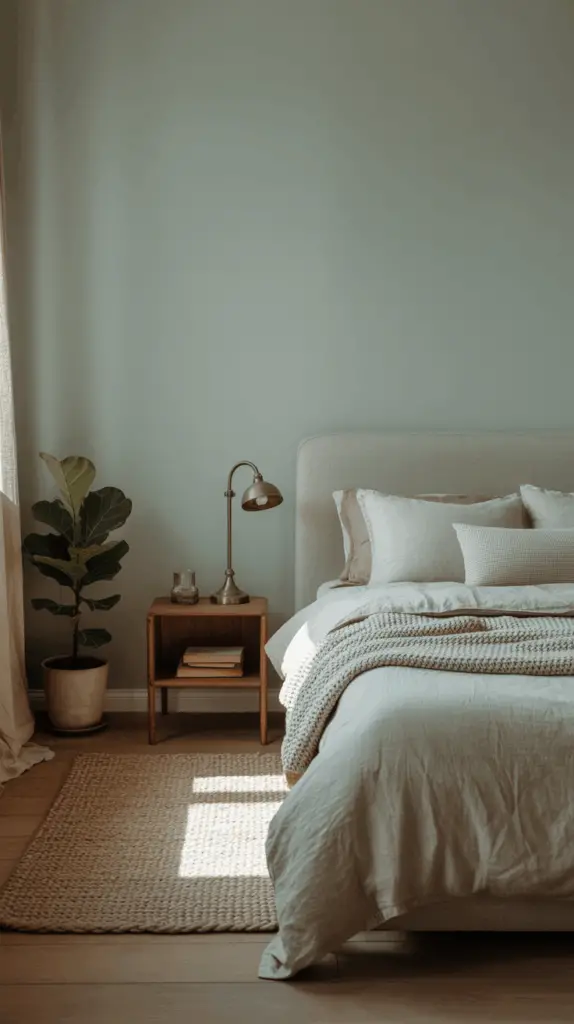Discover the Perfect Calming Bedroom Colors for a Restful Retreat
Table of Contents
Introduction
A good night’s sleep begins with a calm and serene bedroom environment. While the right mattress, pillows, and lighting are essential, one often overlooked but critical factor in creating a restful atmosphere is the color of your bedroom. The colors in your space have a profound effect on your mood, emotions, and overall well-being. Studies have shown that certain colors can promote relaxation, reduce stress, and even help you sleep better.
If you’ve ever found yourself feeling more at ease in a softly colored room than in one with bold or bright hues, you’re not alone. The colors you choose for your bedroom can directly influence how well you unwind after a long day. Whether you are starting from scratch with a complete bedroom makeover or simply looking to refresh your space, selecting the right calming colors is key to creating a restful retreat.
In this post, we’ll explore the best calming bedroom colors and how to incorporate them into your design. From soft blues and greens to warm neutrals, we’ll dive into the shades that encourage relaxation and sleep. Additionally, you’ll learn how to combine these colors effectively to make your bedroom a tranquil sanctuary for rest and rejuvenation.
1. Soft Blues: The Ultimate Tranquil Hue
Soft blues are among the most popular choices for bedroom colors, and for good reason. This hue is known for its calming and serene qualities, often associated with the sky and ocean. Blue shades, especially lighter ones, are said to lower blood pressure and heart rates, which makes them an ideal choice for a bedroom that promotes restfulness.
Light, muted shades of blue, such as powder blue or pastel turquoise, create an airy, open feeling. These colors are ideal for smaller bedrooms, as they make the space feel larger and more inviting. For larger rooms, you can experiment with deeper blues, like navy or slate, to add a sense of intimacy without feeling oppressive.
Pair soft blue walls with neutral furnishings, such as white or beige bed linens, to keep the atmosphere light and breezy. For added warmth, consider incorporating wooden accents or soft, muted fabrics like linen or cotton.
2. Calm Greens: A Connection to Nature
Green is another soothing color that brings the calming essence of nature indoors. It has been shown to promote relaxation and reduce anxiety, making it an excellent choice for a bedroom where tranquility is the goal. The color green is often associated with growth, renewal, and balance, helping to create a harmonious environment.
Soft, muted greens like sage or olive can make your space feel grounded and peaceful. These shades are perfect for those looking to create a natural, organic atmosphere. Green also pairs well with wood, so if you’re considering a natural aesthetic, this color can be an ideal base for your design.
For a more contemporary feel, you can introduce bolder green accents, like emerald or deep forest green, through your throw pillows, curtains, or rugs. These deeper shades add depth and sophistication to the room without overwhelming the space.

3. Warm Neutrals: Cozy and Inviting
Neutrals are timeless, versatile, and easy to incorporate into any bedroom design. While whites and grays are often seen as cold, warm neutrals like beige, taupe, and light brown offer a cozy, inviting feel that can make your bedroom feel more grounded. These hues create a serene backdrop that allows other elements in the room to shine, from decorative accents to furniture pieces.
Warm neutrals are especially effective in bedrooms with limited natural light. They help brighten up the room while still maintaining a soft, relaxing atmosphere. Lighter shades of beige or ivory can make a room feel more spacious and airy, while darker shades like caramel or soft chocolate brown can add warmth and depth.
To avoid a sterile or flat feel, layer different textures and fabrics in neutral tones. Think linen bedding, plush throw blankets, and tactile rugs. Adding plants or natural wood accents will also complement the earthy feel of warm neutrals.
4. Soft Grays: Elegant and Sophisticated
Gray is often seen as a neutral color, but it’s much more than that. Soft gray tones, especially those with blue or green undertones, can create an elegant, calming environment in your bedroom. Gray has the ability to evoke a sense of tranquility and sophistication, making it perfect for creating a chic, serene retreat.
Light gray walls paired with crisp white linens create a minimalist, modern look that feels fresh and clean. If you prefer a cozier atmosphere, consider charcoal or slate gray accents in the form of a duvet, curtains, or decorative pillows. These darker shades add a touch of drama while maintaining a relaxing vibe.
Gray also works well with metallic accents, such as silver or gold, which can elevate the room’s design without adding overwhelming brightness.
5. Lavender and Soft Purples: A Touch of Serenity
Lavender and other soft purple shades bring a sense of calm and luxury to any bedroom. The color purple has long been associated with spirituality, luxury, and tranquility. Lighter shades, such as lavender and lilac, promote relaxation without feeling overly bold or intense.
Lavender is a fantastic choice for a calming, feminine bedroom design. It pairs beautifully with light gray, white, and soft gold accents. If you prefer a more dramatic effect, you can use darker shades of purple, such as plum or aubergine, for accent walls or in your bedding and accessories.
Whether you’re designing a bedroom with a romantic, whimsical vibe or one that’s understated and minimalist, lavender is a great choice for creating an inviting, peaceful retreat.
6. Soft Pink: Gentle and Warm
For those who love subtle, warm tones, soft pink is an excellent option. While pink may not always be the first color that comes to mind for a restful bedroom, when used in the right way, it can create a gentle, soothing environment. Soft, blush pinks or muted peach tones promote a sense of warmth, comfort, and affection.
Pink also pairs well with neutral tones like white, cream, and gray, which help balance its warmth and prevent the room from feeling too feminine or overwhelming. To keep the atmosphere relaxing, avoid overly bright or saturated pinks, and instead opt for pastel or muted shades.
Incorporating pink accents in your bedding, throw pillows, or even your wall color can add a sense of coziness and nurturing to the space.
7. Monochromatic Scheme: Harmony and Balance
One of the most effective ways to create a calming bedroom is to embrace a monochromatic color scheme. This involves using variations of a single color in different shades, tones, and textures throughout the room. A monochromatic palette fosters a sense of harmony and balance, helping to create a unified, restful space.
For instance, you could choose shades of blue, from deep navy to pale blue, and use them in different areas of the room—on the walls, bedding, and accessories. Alternatively, you could go with a neutral tone, such as a series of grays or beiges, to create a calming, sophisticated effect.
The key to pulling off a successful monochromatic scheme is to incorporate different textures and materials to add depth and interest to the room. Combine smooth, soft fabrics with rougher textures, such as woven baskets or a stone accent wall, to prevent the space from feeling flat.
8. The Impact of Lighting and Accessories
The right colors alone can do wonders, but the overall effect of your bedroom is also influenced by lighting and accessories. Lighting can change the way colors appear and create different moods in the space. Natural light will bring out the best in soft hues like blues and greens, while ambient lighting in the evening can soften deeper tones like gray or purple.
When accessorizing your calming bedroom, use soft textiles such as plush throw blankets, cozy rugs, and woven baskets to add texture and comfort. Plants are another excellent addition to any bedroom, as they bring a sense of life and freshness to the space while further enhancing the calm vibe.
Conclusion
Creating the perfect calming bedroom color scheme is an essential step in transforming your bedroom into a restful retreat. From soft blues and greens to warm neutrals and elegant grays, each color has the power to influence the ambiance of your room and enhance your overall well-being. By choosing the right hues and pairing them thoughtfully with textures and accessories, you can create a serene environment that promotes relaxation and restfulness.
No matter your personal style, there’s a color palette that will help turn your bedroom into a sanctuary of peace and comfort. Consider your space, the lighting, and how different colors make you feel, and you’ll be on your way to creating the ultimate restful retreat.

